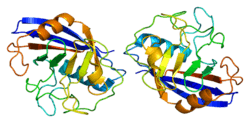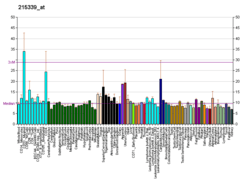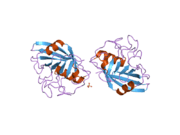NKTR
NK-tumor recognition protein is a protein that in humans is encoded by the NKTR gene.[5][6][7]
This gene encodes a membrane-anchored protein with a hydrophobic amino terminal domain and a cyclophilin-like PPIase domain. It is present on the surface of natural killer cells and facilitates their binding to targets. Its expression is regulated by IL2 activation of the cells.[7]
References
- 1 2 3 GRCh38: Ensembl release 89: ENSG00000114857 - Ensembl, May 2017
- 1 2 3 GRCm38: Ensembl release 89: ENSMUSG00000032525 - Ensembl, May 2017
- ↑ "Human PubMed Reference:".
- ↑ "Mouse PubMed Reference:".
- ↑ Young HA, Jenkins NA, Copeland NG, Simek S, Lerman MI, Zbar B, Glenn G, Ortaldo JR, Anderson SK (Jul 1993). "Localization of a novel natural killer triggering receptor locus to human chromosome 3p23-p21 and mouse chromosome 9". Genomics. 16 (2): 548–549. PMID 8314596. doi:10.1006/geno.1993.1229.
- ↑ Chambers CA, Gallinger S, Anderson SK, Giardina S, Ortaldo JR, Hozumi N, Roder J (May 1994). "Expression of the NK-TR gene is required for NK-like activity in human T cells". J Immunol. 152 (6): 2669–74. PMID 8144875.
- 1 2 "Entrez Gene: NKTR natural killer-tumor recognition sequence".
Further reading
- Frey JL, Bino T, Kantor RR, et al. (1992). "Mechanism of target cell recognition by natural killer cells: characterization of a novel triggering molecule restricted to CD3- large granular lymphocytes". J. Exp. Med. 174 (6): 1527–1536. PMC 2119033
 . PMID 1720812. doi:10.1084/jem.174.6.1527.
. PMID 1720812. doi:10.1084/jem.174.6.1527.
- Rinfret A, Anderson SK (1993). "IL-2 regulates the expression of the NK-TR gene via an alternate RNA splicing mechanism". Mol. Immunol. 30 (14): 1307–1313. PMID 8413330. doi:10.1016/0161-5890(93)90047-F.
- Anderson SK, Gallinger S, Roder J, et al. (1993). "A cyclophilin-related protein involved in the function of natural killer cells". Proc. Natl. Acad. Sci. U.S.A. 90 (2): 542–546. PMC 45699
 . PMID 8421688. doi:10.1073/pnas.90.2.542.
. PMID 8421688. doi:10.1073/pnas.90.2.542.
- Strausberg RL, Feingold EA, Grouse LH, et al. (2003). "Generation and initial analysis of more than 15,000 full-length human and mouse cDNA sequences". Proc. Natl. Acad. Sci. U.S.A. 99 (26): 16899–16903. PMC 139241
 . PMID 12477932. doi:10.1073/pnas.242603899.
. PMID 12477932. doi:10.1073/pnas.242603899.
- Ota T, Suzuki Y, Nishikawa T, et al. (2004). "Complete sequencing and characterization of 21,243 full-length human cDNAs". Nat. Genet. 36 (1): 40–45. PMID 14702039. doi:10.1038/ng1285.
- Sakashita E, Tatsumi S, Werner D, et al. (2004). "Human RNPS1 and its associated factors: a versatile alternative pre-mRNA splicing regulator in vivo". Mol. Cell. Biol. 24 (3): 1174–1187. PMC 321435
 . PMID 14729963. doi:10.1128/MCB.24.3.1174-1187.2004.
. PMID 14729963. doi:10.1128/MCB.24.3.1174-1187.2004.
- Olsen JV, Blagoev B, Gnad F, et al. (2006). "Global, in vivo, and site-specific phosphorylation dynamics in signaling networks". Cell. 127 (3): 635–648. PMID 17081983. doi:10.1016/j.cell.2006.09.026.
- Davis TL, Walker JR, Campagna-Slater V, et al. (2010). "Structural and biochemical characterization of the human cyclophilin family of peptidyl-prolyl isomerases". PLoS Biol. 8 (7): e1000439. PMC 2911226
 . PMID 20676357. doi:10.1371/journal.pbio.1000439.
. PMID 20676357. doi:10.1371/journal.pbio.1000439.
PDB gallery |
|---|
| 2he9: Structure of the peptidylprolyl isomerase domain of the human NK-tumour recognition protein |
|
|

 . PMID 1720812. doi:10.1084/jem.174.6.1527.
. PMID 1720812. doi:10.1084/jem.174.6.1527. . PMID 8421688. doi:10.1073/pnas.90.2.542.
. PMID 8421688. doi:10.1073/pnas.90.2.542. . PMID 12477932. doi:10.1073/pnas.242603899.
. PMID 12477932. doi:10.1073/pnas.242603899. . PMID 14729963. doi:10.1128/MCB.24.3.1174-1187.2004.
. PMID 14729963. doi:10.1128/MCB.24.3.1174-1187.2004. . PMID 20676357. doi:10.1371/journal.pbio.1000439.
. PMID 20676357. doi:10.1371/journal.pbio.1000439.




